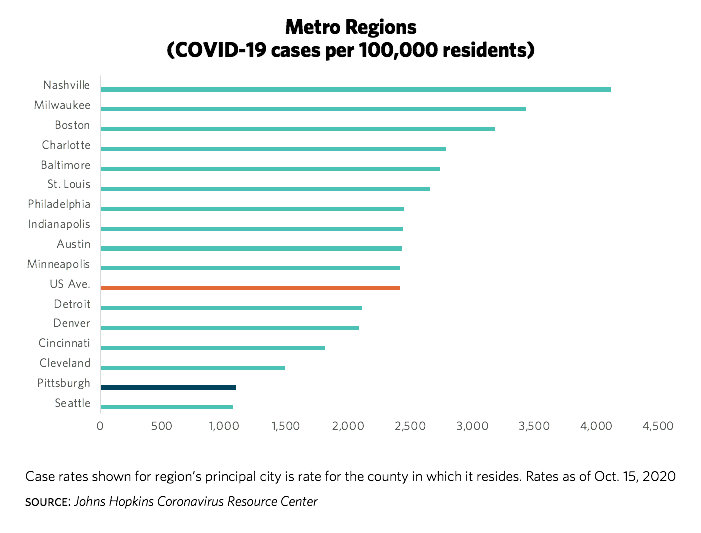Local COVID Cases Are Second-Lowest Among Benchmark Regions

COVID-19 cases rose 29 percent in Allegheny County during the first two weeks of the month. Still, the county’s infection rate is only half the national average—an indication of how cities and towns across the United States are struggling to blunt the most aggressive surge of the coronavirus since the pandemic began nine months ago.
Allegheny County had 1,097 COVID cases per 100,000 residents as of Oct. 15. Only Seattle’s King County had a lower rate among the 16 U.S. metropolitan areas Pittsburgh Today tracks as benchmark regions, according to Johns Hopkins University Coronavirus Resource Center data.
Infections in Milwaukee County and Davidson County, Tenn., home to Nashville were more than three times higher than Allegheny’s tally. The U.S. average of 2,412 cases per 100,000 residents was more than twice as high.
The rates are part of monthly regional COVID analyses done by the Allegheny Conference on Community Development using data reported by the Johns Hopkins center, Allegheny County Health Department and the Pennsylvania Department of Health.
The data suggests that while southwestern Pennsylvania has managed to control the spread of the virus better than most U.S. metro regions, a developing trend puts it at risk of losing ground in the weeks ahead. Infection rates across 10 southwestern Pennsylvania counties rose nearly 68 percent from Oct. 1 through Oct. 15. Pennsylvania as a whole also experienced an increase, but at a rate of less than 43 percent.
The increase in cases was unevenly shared across the region. Westmoreland County was hit the hardest, experiencing a nearly 225 percent increase in confirmed cases during the first two weeks of the month. Butler and Lawrence counties saw their infection rates rise more than 125 percent.
At the same time, Allegheny, Beaver and Indiana counties held increases in infection rates to below 30 percent. And Greene County saw their rate of infections fall 28 percent, the only county in the region where cases declined in the first half of the month.





